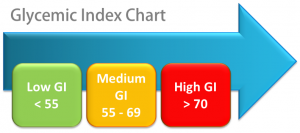By Anthoney J. Andersen – Steroidal.com
Let the truth be told – when it comes to living an active life, diet and exercise are at the top two tiers of the spectrum at helping you achieve and sustain a healthy lifestyle.
Now, even though everyone’s goal is different – some people want to bulk up, while others want to trim away the fat and effectuate lean muscle – the road to greatness is the same: abide by a strict diet plan and exercise regimen.
One of the diet plans that is growing in popularity – especially among athletes and fitness gurus alike – is the glycemic index plan.
GLYCEMIC WHAT?
The glycemic index (GI) is often misconstrued as a diet plan, but actually, it’s used as one of many various tools – a lot like calorie counting or carbohydrate counting – for guiding you toward the right food choices.
The glycemic index follows a particular eating plan that focuses mainly on how foods affect your blood sugar level.
According to Mayo Clinic, the glycemic index is a system that attaches a number to carbohydrate-containing foods according to how much each food increases blood sugar.
Carbohydrates are found in a wide variety of different foods – both healthy and unhealthy – and are a vital part of a high feather diet. Carbs can be found in such foods as bread, beans, milk, popcorn, potatoes, cookies, spaghetti, soft drinks, corn and cherry pie.
According to the Harvard School of Public Health, carbohydrates provide the body with an essential nutrient called glucose. Glucose is converted into energy, which is used to supply the body with the stamina it needs to power through those intense physical activities.
DIABETIC SUCCESS
As it turns out, the glycemic index was originally designed with the intention to help diabetics better regulate their blood sugar levels.
Consuming foods with a low glycemic index transcribes into a diet that reduces sizable fluctuations in blood sugar, and hinders the release of insulin.
According to the American Diabetes Association, beta cells within the pancreas produce the peptide hormone known as insulin. As your body absorbs each meal, beta cells release insulin to help the body use or store the blood glucose it gets from food.
Insulin is normally released by any meal containing protein or carbohydrates, but in more extensive degrees, insulin is based on the kinds of food you eat.
Insulin also promotes the storage of fat by allowing your cells to absorb glucose, which will assist in the overall function of your body’s cells.
In people suffering from type 1 diabetes, the pancreas has simply shut down the production of insulin. The beta cells have been destroyed and they need insulin shots in order to be able to absorb glucose from meals.
Individuals with type 2 diabetes, their bodies are still producing insulin, however, their bodies don’t respond well to it. Some people with type 2 diabetes need to take diabetic pills or insulin shots to help their bodies use glucose for energy.
 WHO SHOULD USE THE GLYCEMIC INDEX?
WHO SHOULD USE THE GLYCEMIC INDEX?
The term ‘glycemic index’ usually refers to a specific diet plan that utilizes the index as the primary or rather the only guide for meal planning. Many commercialized diet plans; diet books and diet websites have based their proposed diet regimen on the glycemic index.
These diet plans include the Zone Diet, Sugar Busters and the Slow-Carb Diet.
The glycemic index is best used as a tool to help you lose and manage your weight. In doing so, you are reducing your risk of chronic diseases related to obesity and cardiovascular disease.
According to Mayo Clinic, a person might consider following the glycemic index if you:
- Want to lose or maintain a healthy weight.
- Need assistance planning healthier meals.
- Need help maintaining blood sugar levels as part of a diabetes treatment plan.
THE MARVEL OF LOW-GLYCEMIC EATING
If you’re considering taking on a diet and meal plan that surrounds itself around the laws of the glycemic index, then focus on eating – as well as avoiding – these types of foods:
- Eating unprocessed or under-processed types of grains. These include brown rice, millet, wheat berries and whole barley.
- Focus on eating beans and non-starchy vegetables: peaches, pears, apples and all types of berries, which have been known to have a low glycemic index.
- High calorie foods – like ice cream, cakes and pies, for example – should be avoided. Concentrated fruit juices should be avoided as well, or at the very least, consumed in moderation, because they can create a surge in your blood sugar levels.
THE WRAP UP
The glycemic index can be a very useful tool to adhere by if you’re looking to manage or maintain your weight. It’s especially pragmatic if you suffer from type 1 or type 2 diabetes, and are looking for a healthier meal plan that will help you with your ongoing treatment.
As with most things in life, do your research first and talk to your doctor before committing your body to a diet plan that may otherwise not be suited to your best interest and overall well being.
Be smart. And stay healthy.







